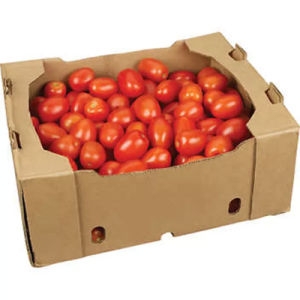Fruit Packaging Market Insights: 2023, Industry Segment Analysis, Growth Rate, and ChallengesPosted by Pearl Smith on April 13th, 2023  Fruit packaging refers to the various methods and materials used to package and protect fruits for transportation, storage, and sale. Fruit packaging serves multiple purposes, including preserving the freshness and quality of the fruits, preventing physical damage, providing branding and marketing opportunities, and meeting regulatory requirements. Here are some common types of fruit packaging: ◘ Cardboard boxes: Cardboard boxes are a popular choice for fruit packaging due to their versatility, affordability, and recyclability. They come in various sizes and can be used to package a wide range of fruits, from apples and oranges to berries and cherries. Cardboard boxes can be printed with branding and product information, and they can be easily stacked and transported. ◘ Mesh bags: Mesh bags are commonly used for packaging fruits such as oranges, avocados, and onions. The mesh material allows for air circulation, which helps to extend the shelf life of the fruits and prevents moisture buildup that can cause spoilage. Mesh bags are lightweight, inexpensive, and visually appealing, as consumers can see the fruits inside. ◘ Plastic containers: Plastic containers, such as clamshells and punnets, are commonly used for packaging small fruits like berries, grapes, and cherry tomatoes. Plastic containers provide visibility of the fruits, offer protection from damage, and can be resealable to maintain freshness. However, plastic containers can be less environmentally friendly compared to other packaging options and may need to be recycled properly. ◘ Flexible films: Flexible films, such as shrink wrap or stretch wrap, are used to package fruits with irregular shapes or sizes, such as watermelons, pineapples, or cucumbers. These films conform to the shape of the fruit, providing a protective barrier against moisture and physical damage. Flexible films can also be printed with branding and product information. ◘ Biodegradable and compostable packaging: With growing awareness of environmental concerns, biodegradable and compostable packaging options are becoming more popular for fruit packaging. These materials are made from renewable resources and are designed to break down naturally over time, reducing environmental impact. Biodegradable and compostable packaging options include materials like bioplastics, paper-based materials, and compostable mesh bags. ◘ Sustainable packaging: There is increasing demand for sustainable packaging options in the fruit industry. These may include packaging made from recycled materials, packaging that is reusable or recyclable, or packaging that uses minimal materials. Sustainable packaging aims to reduce waste, minimize environmental impact, and meet consumer preferences for eco-friendly options. The fruit packaging market is a significant segment of the global packaging industry and is driven by various factors such as the increasing demand for fresh fruits, changing consumer preferences, advancements in packaging technologies, and growing awareness about sustainability and environmental concerns. The fruit packaging market encompasses a wide range of packaging materials, including cardboard, plastic, mesh, flexible films, and biodegradable/compostable materials, as well as different types of packaging formats such as boxes, bags, containers, and wraps. Key players operating in the global fruit packaging market include Smurfit Kappa Group Plc, Sonoco Products Company, Mondi Group Plc, Bemis Company, Inc., International Paper Company, Linpac Packaging Limited, Sealed Air Corporation, and Amcor Limited among others. Several factors are driving the growth of the fruit packaging market: • Increasing demand for fresh fruits: The rising global population, urbanization, and changing dietary habits are driving the demand for fresh fruits. Proper packaging plays a crucial role in preserving the freshness and quality of fruits, extending their shelf life, and reducing spoilage during transportation and storage. • Changing consumer preferences: Consumers are increasingly seeking convenient, visually appealing, and sustainable packaging for their fruits. Packaging that provides easy handling, enhances the aesthetics of the product, and aligns with environmental concerns, such as biodegradable or compostable materials, is gaining popularity among consumers. • Advancements in packaging technologies: Packaging technologies are continuously evolving to meet the changing demands of the fruit industry. Innovative packaging solutions, such as modified atmosphere packaging (MAP) that helps to extend the shelf life of fruits, smart packaging with sensors for monitoring freshness, and active packaging with antimicrobial properties, are gaining traction in the fruit packaging market. • Growing awareness about sustainability: Sustainability has become a key focus in the packaging industry, including fruit packaging. Consumers and stakeholders are increasingly concerned about the environmental impact of packaging materials, leading to a demand for sustainable options such as recycled materials, biodegradable or compostable materials, and reusable packaging. • Increasing regulations and standards: There are various regulations and standards related to food safety and packaging, which impact the fruit packaging market. These regulations aim to ensure that packaging materials are safe for food contact, protect the integrity of the fruits, and meet environmental requirements. Compliance with these regulations is driving the adoption of certain packaging materials and formats in the fruit packaging market. • Growing e-commerce and online grocery shopping: The rise of e-commerce and online grocery shopping has also impacted the fruit packaging market. Packaging for fruits that are sold online needs to be durable, visually appealing, and able to protect the fruits during transportation. This has led to increased demand for packaging materials and formats that are suitable for e-commerce, such as lightweight, easy-to-handle, and visually appealing packaging options. The demand for fruit packaging is influenced by various factors, including consumer preferences, market trends, and industry dynamics. Here are some key factors driving the demand for fruit packaging: ➢ Consumer demand for convenience: Consumers are seeking convenient fruit packaging options that are easy to handle, transport, and store. Packaging formats such as pre-packaged fruit cups, single-serving packs, and resealable bags are gaining popularity due to their convenience and ease of use. ➢ Emphasis on freshness and quality: Packaging plays a crucial role in preserving the freshness and quality of fruits. Consumers prefer fruit packaging that can protect the fruits from damage, reduce spoilage, and extend their shelf life. Packaging materials and technologies that help maintain the freshness and quality of fruits, such as modified atmosphere packaging (MAP), vacuum packaging, and barrier films, are in high demand. ➢ Sustainability and environmental concerns: Growing awareness about sustainability and environmental concerns is driving the demand for eco-friendly fruit packaging options. Consumers are increasingly looking for packaging materials that are recyclable, biodegradable, compostable, or made from renewable sources. Sustainable packaging options, such as paper-based packaging, bio-based plastics, and compostable films, are gaining traction in the fruit packaging market. ➢ Branding and visual appeal: Packaging plays a significant role in product branding and attracting consumers' attention. Eye-catching packaging designs, attractive colors, and appealing graphics can influence consumers' purchasing decisions. Packaging options that offer customization, branding opportunities, and visual appeal, such as printed boxes, labels, and wraps, are in demand to enhance the shelf appeal of fruits. ➢ Changing retail landscape: The retail landscape is constantly evolving, with the rise of e-commerce, online grocery shopping, and changing consumer shopping behaviors. Packaging for fruits sold online needs to be durable, visually appealing, and suitable for transportation, which is driving the demand for specialized e-commerce packaging solutions for fruits. ➢ Food safety and regulatory compliance: Food safety is a critical concern for consumers, and packaging plays a vital role in ensuring the safety and integrity of fruits. Stringent regulations and standards related to food safety and packaging, such as FDA regulations, EU regulations, and industry standards, are driving the demand for packaging materials and formats that comply with these regulations. Fruit packaging has various applications across the fruit supply chain, from farm to consumer. Here are some key applications of fruit packaging: ✤ Transportation and distribution: Packaging plays a crucial role in protecting fruits during transportation and distribution. Packaging materials and formats such as corrugated boxes, crates, and pallets are commonly used for bulk transportation of fruits from farms to distribution centers or retail stores. These packaging options are designed to provide adequate protection against physical damage, moisture, and other environmental factors during transit. ✤ Storage and warehousing: Fruit packaging is used for storing fruits in warehouses and distribution centers before they reach the retail shelves. Packaging materials such as breathable films, mesh bags, and cardboard boxes are used for storing fruits in controlled environments, maintaining the right temperature, humidity, and ventilation to extend their shelf life. ✤ Retail display: Packaging plays a critical role in attracting consumers at the retail level. Packaging options such as clamshells, trays, and bags are used for displaying fruits on retail shelves in an attractive and organized manner. These packaging options are designed to showcase the fruits, provide product information, and ensure food safety and hygiene. ✤ Convenience and portion control: Packaging is used to provide convenience to consumers and offer portion control options. Pre-packaged fruit cups, single-serving packs, and resealable bags are popular packaging formats that offer convenience and portion control, allowing consumers to consume fruits on-the-go, store leftovers, or manage portion sizes. ✤ E-commerce packaging: With the growing trend of online grocery shopping, specialized e-commerce packaging options for fruits are gaining prominence. Packaging materials such as corrugated boxes, insulated boxes, and protective films are used to ensure the safe transportation of fruits purchased online. These packaging options are designed to withstand the rigors of shipping and protect fruits from damage during transit. ✤ Sustainable packaging: Sustainability is a key application of fruit packaging. Packaging materials such as biodegradable films, compostable bags, and paper-based packaging options are used to reduce the environmental impact of packaging and meet the increasing demand for sustainable packaging from environmentally conscious consumers. ✤ Branding and marketing: Packaging is used as a branding and marketing tool for fruits. Eye-catching packaging designs, attractive colors, and appealing graphics help create brand recognition, attract consumers' attention, and influence their purchasing decisions. Customized packaging options such as printed boxes, labels, and wraps are used for branding and marketing purposes, creating a unique identity for fruits in the market. In summary, fruit packaging has various applications across the fruit supply chain, including transportation and distribution, storage and warehousing, retail display, convenience and portion control, e-commerce packaging, sustainable packaging, and branding and marketing. Fruit packaging is designed to protect fruits, ensure food safety, provide convenience to consumers, meet sustainability goals, and enhance the marketability of fruits. Like it? Share it!More by this author |


